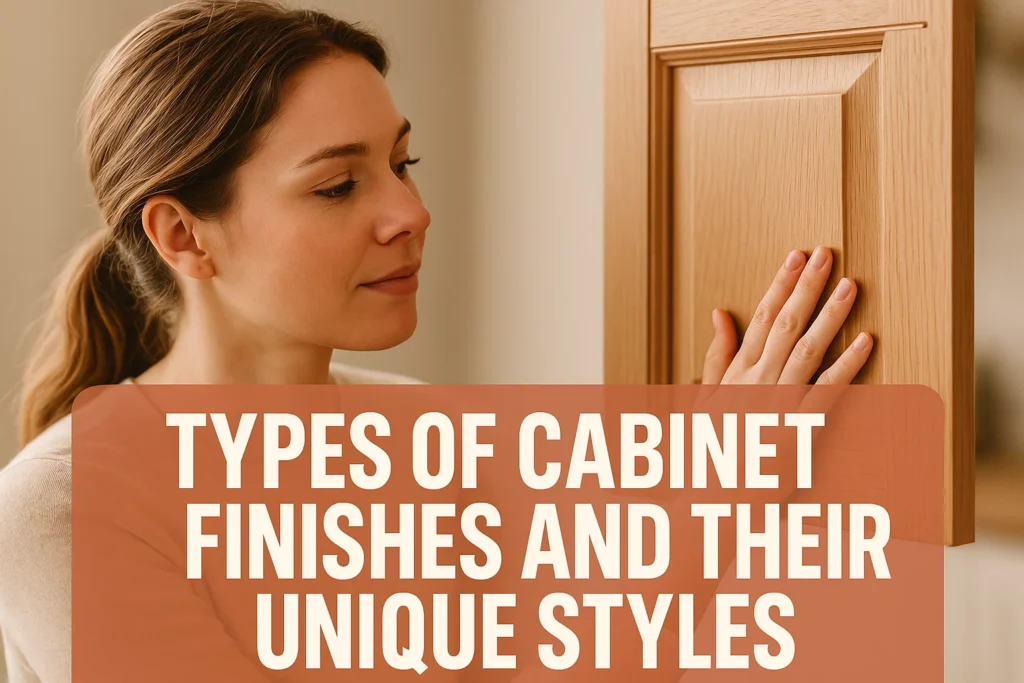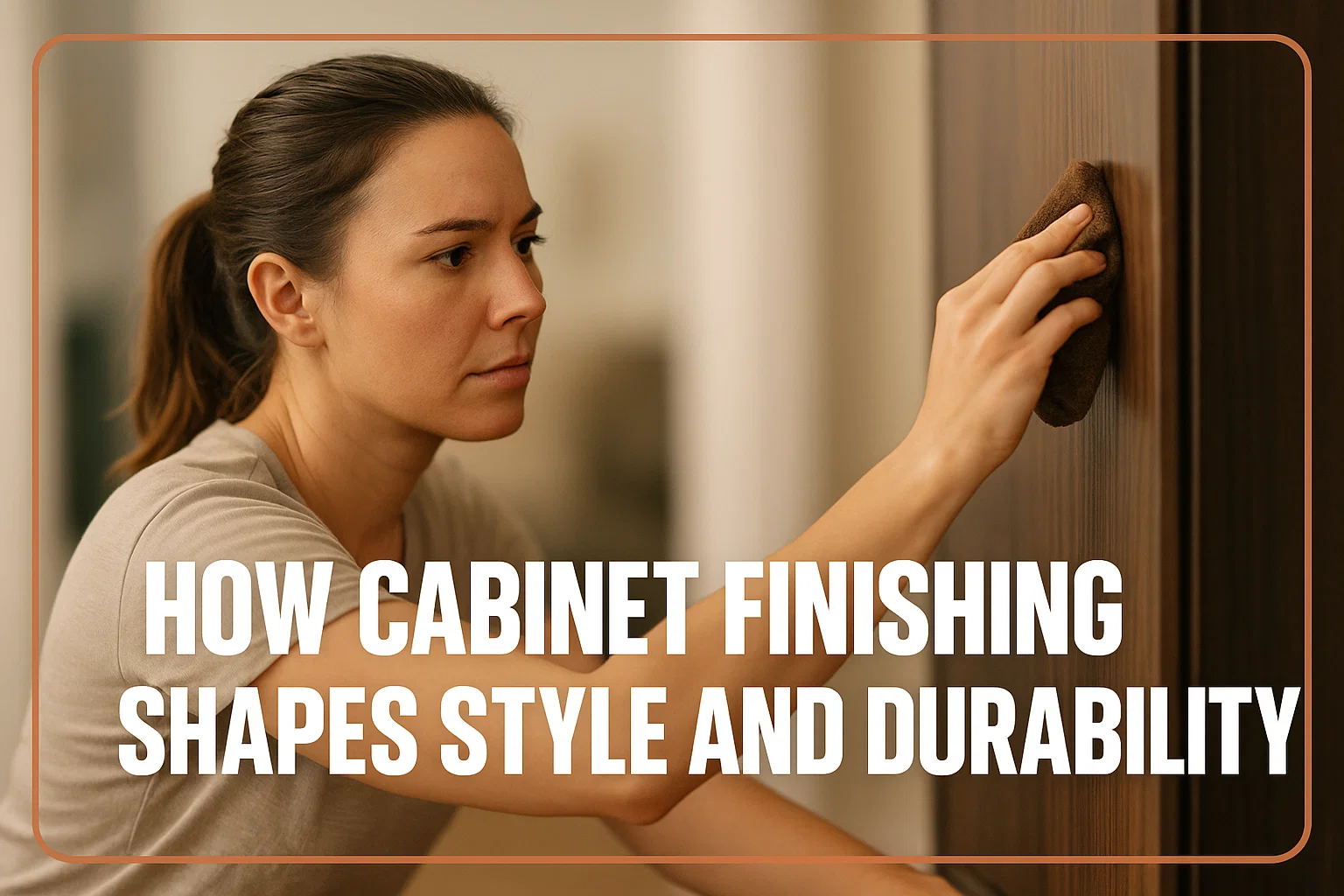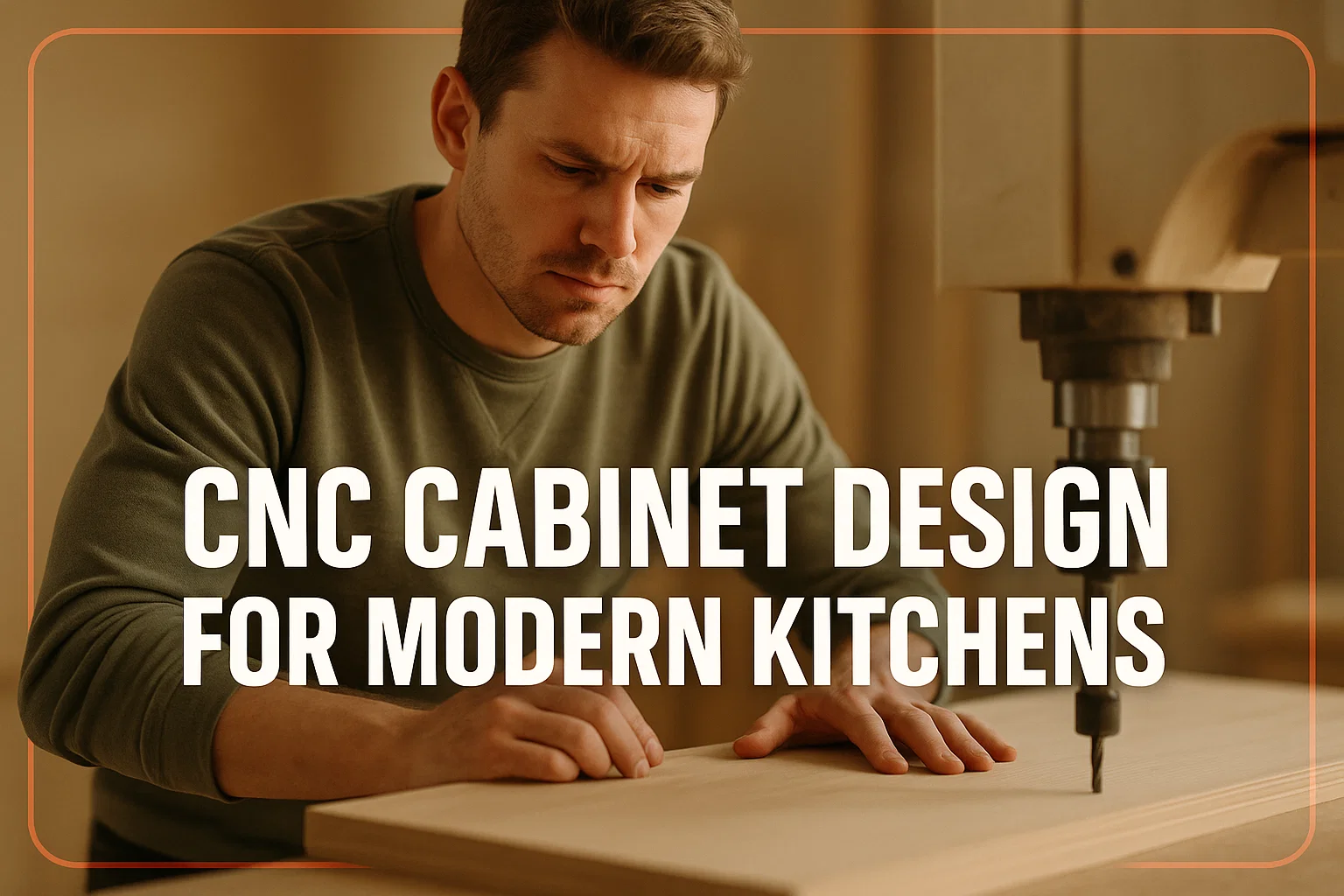Consider kitchen cabinets for a moment. They are not just cupboard spaces behind doors but the core of the kitchen style and the unsung heroes that bear the brunt every day. The key to ensuring your cabinets remain looking fresh, stylish and strong? They are all finished.
Selecting the appropriate finish to your cabinets is not only about aesthetic choices but how to preserve your investment and protect your cabinets against spills, scraping, and steam from everyday cooking. Is your style lean and cool, warm and relaxed, or is it somewhere in the middle? Regardless of your taste, the finishing of your cabinets would give a complete makeover to the entire kitchen, in addition to its quality lifespan.
In this article, we are going to look at why custom cabinet finishes are important, which ones are more popular, what influences their durability, and how to maintain them for years of beauty and strength.
What is Cabinet Finishing and Why Does It Matter?
Cabinet finishing involves applying the finishing coats in order to protect cabinets as well as decorating the cabinets, adding a new smartness to them besides making them resistant not only in terms of durability, but also in terms of weather. A quality coat protects the wood against water and heat, cuts, and marks, which are frequent problems in the kitchen and high-traffic areas.
Easy Ways to Choose the Perfect Finish For Your Cabinets
The choice of finish used on the kitchen cabinets does not have to be puzzling. Here are a few easy pointers in making the decision:
Consider Your Kitchen Aesthetics
Consider the general style you require in your kitchen. Is your style more natural, warm or more modern, shiny? The kind of finish that you select can be a major aspect in the way your kitchen feels.
The Material of the Finish
The various finishes could be effective on different materials. As an example, laminate cabinets may have a durable finish on their own, and natural wood can be best matched with clear finishes. Match the finish to the material of your cabinets to produce the best outcomes.
Maintenance Requirements
Other finishes require a bit more attention compared with others If you prefer easy-to-maintain paint, make sure to choose easy-to-clean paint that does not require constant expensive touch-ups. If you don’t mind some upkeep, you have more options to choose from.
Consider Your Lifestyle
Choose a finish that withstands busy family life like kids and pets are present in your home or in a busy kitchen, chances are you will need a finish that can take a beating. Stronger materials such as lacquer or laminate are best in busier areas and will help your cabinets prove more durable over the years.
Types of Cabinet Finishes and Their Unique Styles

So, since we now understand that finishing matters a lot, let us take a look at some of the most popular cabinet maker finishes and how they can define the personality of a kitchen, and also how they stand in terms of wholesome health benefits and risks.
1. Natural Wood Cabinet Finishes
Wood grains are natural wood finishes that bring out the natural beauty of wood, warmth and an organic force to the interior. These types of finishes normally entail clear sealants or natural oils to bring out the texture and the color of specific wood without hiding them under the finish. The greatest asset here is the ever classic, inviting aura that only real wood produces. However, such finishes sometimes demand just a little more attention as they may require periodic maintenance and re-coating, in particular to defend against water.
2. Lacquered Wood Cabinets
Lacquered finish also renders a sleek, hard, and glossy application quickly to provide a defensive coating. This finish goes well with modern kitchens that want more polished and clean lines with a smooth surface that wipes clean. The main advantages are the robustness when it comes to moisture and stains, yet it can also become tending to fingerprints and small scratches. Obtaining a good lacquer finish would normally require a professional and avoid spots.
3. Painted Kitchen Cabinets
Repainting your cabinets puts you in the realm of color possibilities by enabling you to design anything between a dramatic statement cabinet or a subdued ,muted backdrop of a cabinet. Paint can also be incredible at covering flaws and refreshing cabinets that are older cabinets. Painted finishes are one of the best because it is simple to update or refresh with another color. On the one hand, failing to properly apply the paint can make the paint chip or peel during the course of time, and the grain structure of the wood underneath is concealed, losing out on that warmth of the wood.
4. Glazing Techniques
Glazing has the effect of adding a layer of translucency over the paint or stain, making your cabinets textured or aged or both. This is the best method if you want to have a traditional, vintage or antique style. Glazing highlights trim work such as carvings and mouldings, and it makes your cabinets appear old-world elegant. Although stunning, glazed finishes are not always that easy to clean and maintain, and therefore are more suitable for those who like detail and texture.
5. Laminate Finished Cabinets
Laminate finishes are where a hard plastic coated material is bonded to the surface of the cabinet. Laminate is highly moisture, scratch, and wear resistant – a benefit in a busy kitchen. Laminate is also available in almost any color combination and design, including wood- and stone-imitation. The negative side is that it is artificial in appearance; laminate rarely has the warmth and integrity of natural wood, and being damaged, laminate might be difficult to fix or refinish.
Factors That Impact Cabinet Finish Durability
Selecting the suitable cabinet finishing is only the beginning of the matter of fact The duration, as well as how resistant it is to daily use, is dependent on various key factors. This knowledge can guide you in making better decisions and properly taking care of your cabinets in the hope that they will last longer and look good.
Material Quality
Any lasting finish can only start with the quality of the material beneath the finish. Quality wood can naturally receive finishes on it better because it is not as likely to warp, crack, or absorb too much moisture. Similarly, top-quality finishing products, such as lacquer, paint, or sealant, are developed to have longer durability and improved adhesion. Durable solid hardwood with quality finish can usually be worth it in the end, with cabinets that look good and perform well long term.
Environmental Exposure
The surrounding environment of your kitchen contributes a lot in terms of finish durability. Cabinets located by windows or heaters may be exposed to unavoidable sunlight or changes in temperature that can lead to sun fading, discoloration, or even warping. This is because high humidity especially in kitchen and bathroom areas, may pose a challenge to finishes as it encourages the build-up of moisture that is absorbed into the wood. Proper ventilation and finishes that are specially manufactured to last these conditions can help combat these natural factors and maintain a flawless look on cabinets.
Daily Use and Wear
Consider the number of times in a single day that you open and close the doors of the cabinets, wipe up food or drinks, or even just rest against the cabinet space. This daily wear and tear tends to abrade off any finish. Protective coatings can lose their protective effect by being subject to regular cleaning under harsh conditions and/or abrasive tools, as well as being bumped into or even scratched. The busier your kitchen is, the better a finish you would require, and a soft cleaning scheme to protect those surfaces.
Application Method
And lastly but not least, the way your cabinet finish is applied largely contributes to its durability. Professional finishing experts will utilize exact methods to make sure that the coating secures effectively and dries evenly. They tend to use numerous thin coats and sanding between them, which makes them much more protective against being damaged. On the one hand, rush applications and/or do-it-yourself can cause uneven coverings, bubbling or peeling quickly. Skilled application is not only a matter of look and feel, but it also crucially involves taking into account the need to provide lasting protection.
How to Protect Your Wood Cabinet Finish
- Wipe your cabinets with a soft cloth and mild soap, and warm water.
- Avoid scrubbers that are abrasive, hard sponges, and harsh chemicals that can wear the finish out.
- Put cabinet liners or protective cushions in shelves and drawers to avoid scratches and stains.
- Blot up spills as soon as they occur before they penetrate the wood and cause stains or damage.
- Check your cabinets regularly to notice scratches, chips, dull areas, and immediately touch them up using matching finishes or repair kits.
- Not to put hot things on cabinet tops so as not to damage them with heat.
- Take care of using handles and knobs in such a manner that wear would be reduced in areas of frequent contact.
Conclusion
Your cabinet finish does more than just look good; it also protects your cabinets and determines the style of your kitchen. As much as wood finish, lacquer, paint, glazing, and laminate are of preference, the right finishing keeps your cabinets in their place longer in order to maintain their durability and attractiveness.
Care and maintenance. Reliable information on the type of finishes, their durability, and care can help you enjoy the kitchen more by having an attractive and durable kitchen. If you’re ready to upgrade your cabinets with the perfect finish, customcabinetstx.com is here to help you make it happen.
FAQ’s
It depends on how often your cabinets are used and what type of finish is applied; more often than not, refinishing is less expensive than replacing cabinets. On average, every 7 to 15 years, a cabinet could use a refinish to make it last longer and be able to keep its new-looking face.
DIY can happen but it may be time-consuming and requires skills to do smoothly and permanently.
Although painted cabinets can chip or peel out during the passage of time, they can easily be repaired by being touched up. Natural wood finish, on the other hand, may need to be resealed or oiled at regular intervals to ensure that the wood does not dry out and become worn.
Lacquer or laminate finishes usually have superior moisture resistance.



